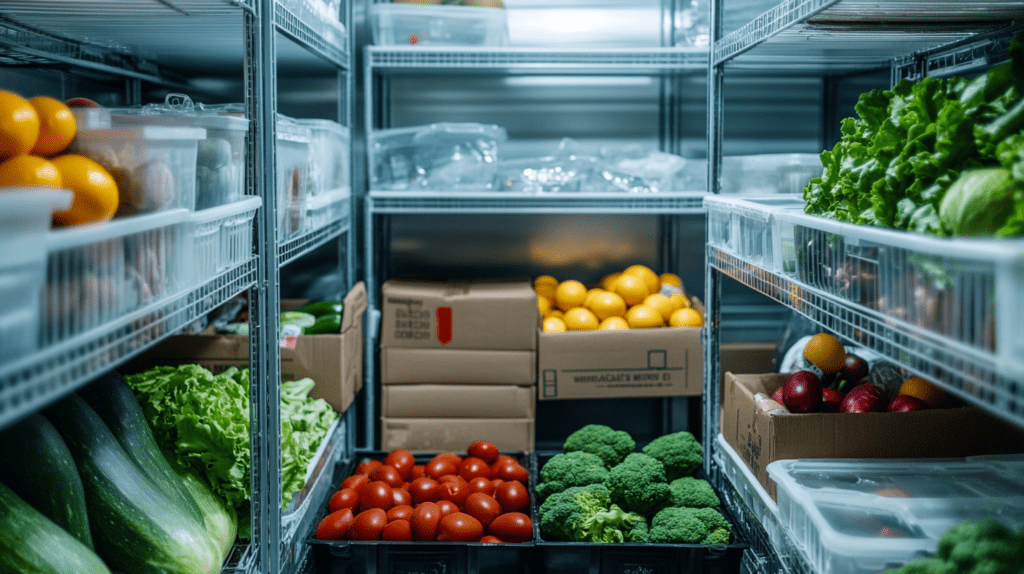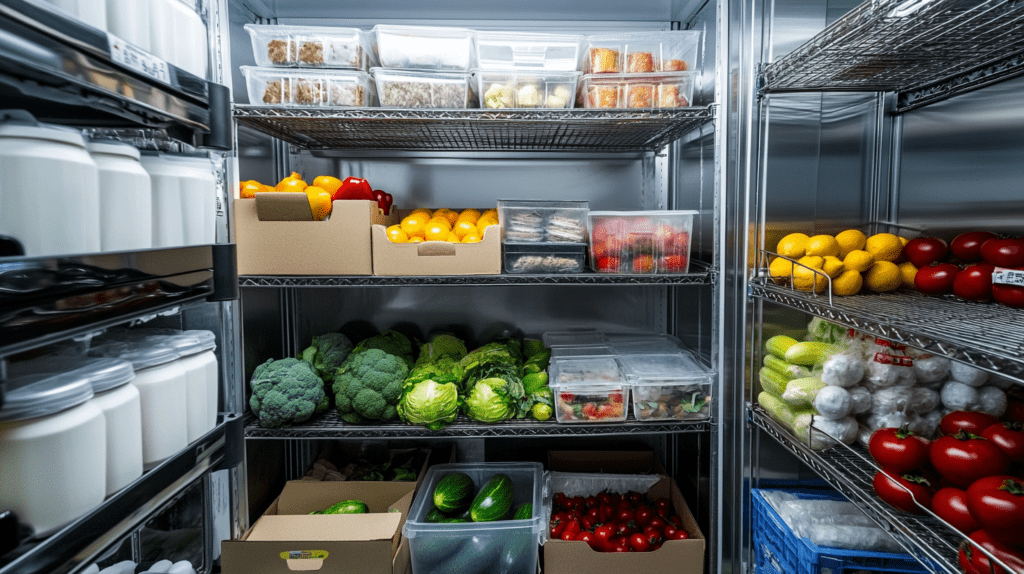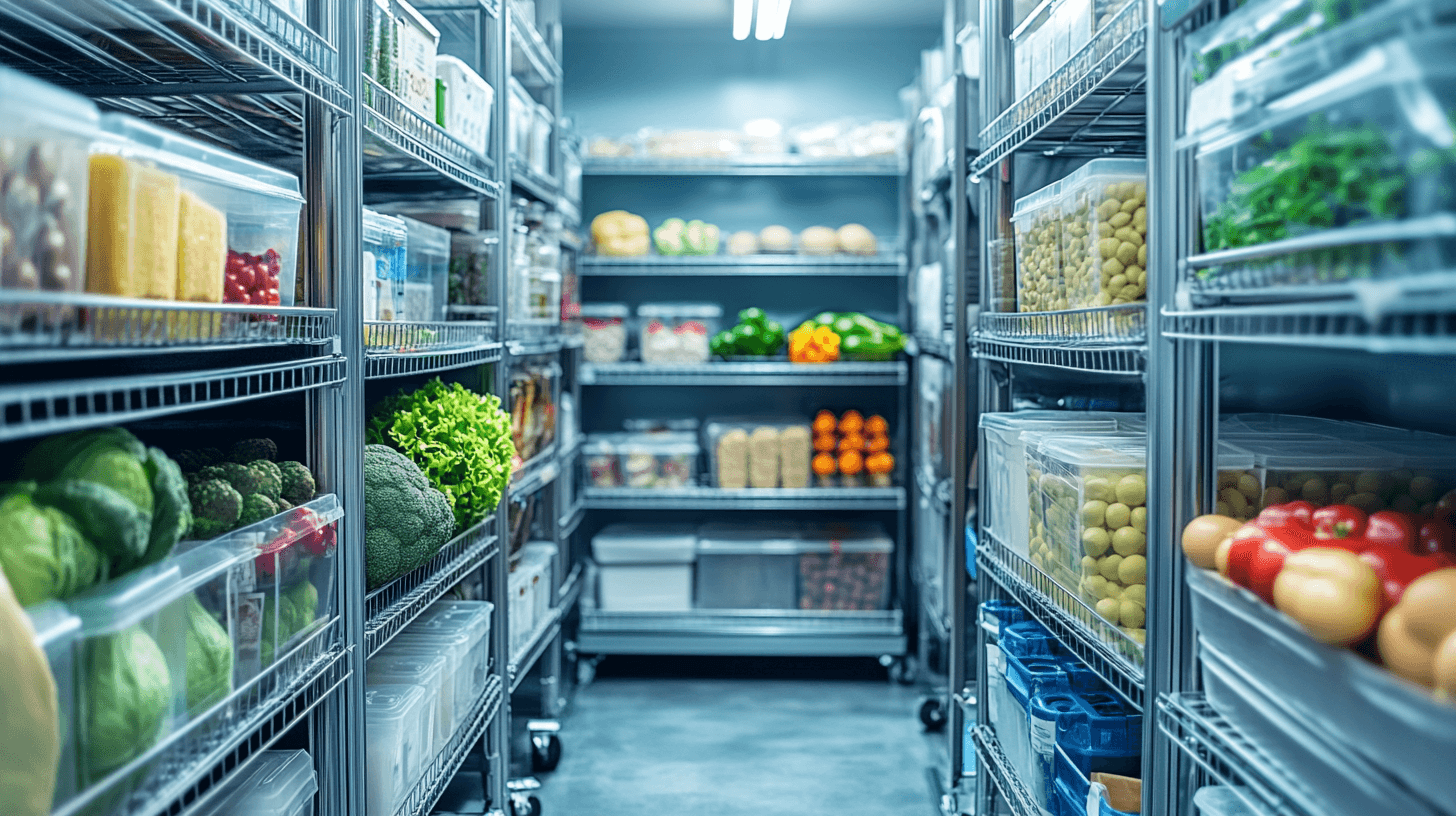If you’ve struggled to keep your restaurant’s fridge organized, a Walk In Cooler Food Storage Chart can help guide you in food safety. 🌟 It’s like making sure your shoes are tied before racing out the door—you just don’t skip it. This blog will guide you through the ins and outs of using these charts to keep everything as fresh as a daisy and prevent foodborne illnesses.
Table of Contents
ToggleThe Basics of Walk In Cooler Food Storage Chart.


Food Storage and Safety in Walk-in Coolers
In Houston, we say, “Don’t put the cart before the horse.” We need to first understand why proper food storage is important. Food safety isn’t just an afterthought—it’s the backbone of any successful food operation. Proper food storage prevents nasty pathogens like salmonella from getting cozy in your walk-in cooler. Trust us, no one wants to deal with that kind of contamination.
Temperature control plays a starring role here. Keeping your cooler food at the ideal temperature helps prevent the growth of pathogens that love to spoil the party. It ensures food safety and quality, keeping everything fresh and delightful.
What is a Walk In Cooler Food Storage Chart?
Now, let’s talk about that food storage chart. It’s like the GPS for your cooler—a handy guide that steers you in the right direction. Each chart outlines the best storage practices for various food types, including raw meat and ready-to-eat foods. They help prevent cross-contamination and keep everything neat and tidy.
The Importance of Temperature in Walk-in Coolers


Maintaining the Correct Temperature for Food Storage
Temperature control is like your secret weapon against foodborne illnesses. When it comes to refrigeration, keeping food at the correct temperature is key. For most stored food, that means 40°F or below. Use a trusty thermometer to ensure things are running smoothly.
Incorrect temperatures can lead to spoilage and increase the risk of foodborne illnesses. Nobody wants to be responsible for making someone sick because of improper food storage practices.
How to Prevent Foodborne Illness by Storing Food at the Correct Temperature
Storing food at the correct temperature is the best way to keep it safe and tasty. Refrigeration slows down the growth of harmful bacteria, reducing the risk of foodborne illness. It also helps reduce food waste by extending the freshness of your stored food.
If you’re still scratching your head about how to make sure everything stays at the right temperature, don’t worry. We’ve got plenty of tips and tricks up our sleeve to help you out.
Best Practices for Storing Food in a Walk-in Cooler


Organizing Food for Maximum Safety
Now, let’s tackle organization. Picture your walk-in cooler as a well-organized pantry, where everything has its place. Store raw meat on the bottom shelf to avoid any drips contaminating other food. Use proper storage containers to prevent cross-contamination and spoilage.
What would be a prime example of an ideal storage arrangement? Place fruits and veggies on the top shelves, cooked foods in the middle, and raw meats at the bottom. This arrangement keeps everything safe and sound.
How to Arrange Food in a Walk-in Cooler
Arranging food properly in your walk-in cooler is like playing a game of Tetris. Make sure you maximize space while keeping things orderly. When you arrange food, follow the food storage chart’s guidelines for storage order and temperature control.
Practical tips? Label everything with the date it was prepared, and use built-in thermometers to monitor the internal temperature. It’s all about maintaining food safety and quality.
The Role of Storage Containers and Food Safety


Choosing the Right Storage Containers for Walk-in Coolers
Storage containers are unsung heroes when it comes to storing food in a walk-in cooler. They help prevent the growth of harmful bacteria and maintain food safety. Choose containers that are easy to clean and stackable for maximum efficiency.
Metal or plastic containers are your friends here. Avoid glass, which can be a bit of a headache in a busy kitchen environment. Remember, your goal is to prevent spoilage and ensure food safety.
Using a Walk In Cooler Food Storage Chart: Step-by-Step Guide


How to Use a Walk In Cooler Food Storage Chart for Maximum Safety
Step right up for our step-by-step guide on using a food storage chart. First, familiarize yourself with the chart’s layout and guidelines. Next, categorize your food items and use the chart to determine their ideal storage location.
Examples? Store eggs that will be served immediately in a separate bin from raw fish. Follow the guide to ensure food is stored at the correct temperature and in the proper order. It’s all about reducing the risk of foodborne illness.
Reducing the Risk of Foodborne Illness with a Walk In Cooler Food Storage Chart
Using a food storage chart is like having a safety net—it catches any potential mistakes before they become big problems. By following the guide, you significantly reduce the risk of foodborne illness. Real-life examples show that businesses with well-organized coolers have fewer instances of contamination.
Expert Tips and Common Mistakes to Avoid


Expert Tips for Maintaining Food Safety in Walk-in Coolers
We’re not saying we’re experts, but we’ve been around the block a few times. From keeping food at the correct temperature to avoiding cross-contamination, there are some tried-and-true tips that can help. Maintain a regular deep clean schedule for your walk-in cooler to keep everything in tip-top shape.
Common Mistakes to Avoid When Using a Walk-in Cooler
Even the best of us make mistakes. But when it comes to food storage, it’s best to avoid them altogether. Common pitfalls include overcrowding the cooler and failing to monitor temperature data. Avoid these mistakes to ensure safety and quality in your food storage.
Ensure Food Safety and Quality with Proper Walk-in Cooler Storage Practices


In conclusion, using a Walk In Cooler Food Storage Shart is like having a trusty sidekick in your food safety endeavors. It helps you organize, store, and monitor food properly, preventing foodborne illnesses and ensuring freshness.
Don’t be shy—get started with your own Walk In Cooler Food Storage Chart today. Implement these tips and tricks to keep your business running smoothly and your customers happy. After all, in Houston, we know how to take care of our own.
🤠 Houston’s Cool FAQ Section
What Are Typical Walk-In Cooler Sizes?
When it comes to walk-in coolers, they can vary quite a bit. Sizes typically range from 6×6 to 8×8 or larger, depending on your needs and available space. Remember, it’s about more than just sticking a big ‘ol box in there; think about how much room you actually need and how you plan to use it.
What Are the Sizes of Coolers?
Ah, coolers come in all sizes, just like hats at the rodeo. From small units around 50 cubic feet to hefty monsters reaching 300 cubic feet or more for larger operations. Each size serves different needs, so reckon on what’s best for your line of business.
What Size Are the Panels for a Walk-In Cooler?
The panels for these tough-as-nails walk-in coolers are typically 4 inches thick, but they can range up to 8 inches for keeping Texas heat at bay. These panels are crucial ‘cause they work like your trusty winter jacket, keeping the cold locked in.
How Small Can a Walk-In Cooler Be?
Well partner, even the smallest walk-ins need to pack a punch. Sizes can go as tiny as 4×6 feet but remember, smaller ain’t always better if you have a lot to store. It’s all about matching the size of the unit with your storage needs.
What Exactly is a Condensing Unit?
A condensing unit is the engine of your cold storage, keeping items frozen and fresh, even in hot Houston summers. Just like how a horse powers a wagon, this unit propels the cooling process.
Why Consider Refrigeration for My Outdoor Installations?
When it gets hotter than a jalapeño out here, having an outdoor walk-in size option can be a lifesaver. It’s important to choose an outdoor setup that fits your operations and adapts to Houston’s unpredictable weather, not just for storage.
🤝 Reach Out & Stay Chilled, Y’all! ❄️
Friends, have you ever felt like you need a hand wrangling your Walk In Cooler Food Storage Chart like a pro? We’re here to lend that helping hand and make sure your kitchen stays as chill as a Houston evening breeze. If you need advice or want to discuss how Turbo Air and Carrier can improve your food storage, we’re here to help!
👉 Contact Us: Just holler at us right here or give us a call at +1 (281) 818-5959. We’re ready to saddle up and ride into new chilling adventures with you.
🤠 Join Us on Social Media: Hop on over to our LinkedIn for the latest scoop in the world of cooling. It’s where we share all things cooler and connect with folks like you!
📺 Video Library: Get the lowdown on all things cooler-related in our YouTube channel. It’s like having your own digital icebox to open anytime you need a cool tip or trick!
So, partner, don’t be shy—explore, engage, and expand your walk-in cooler skills with us at Unity Cooling Systems. We’re not just about keeping it cool; we’re about keeping it cool together!






